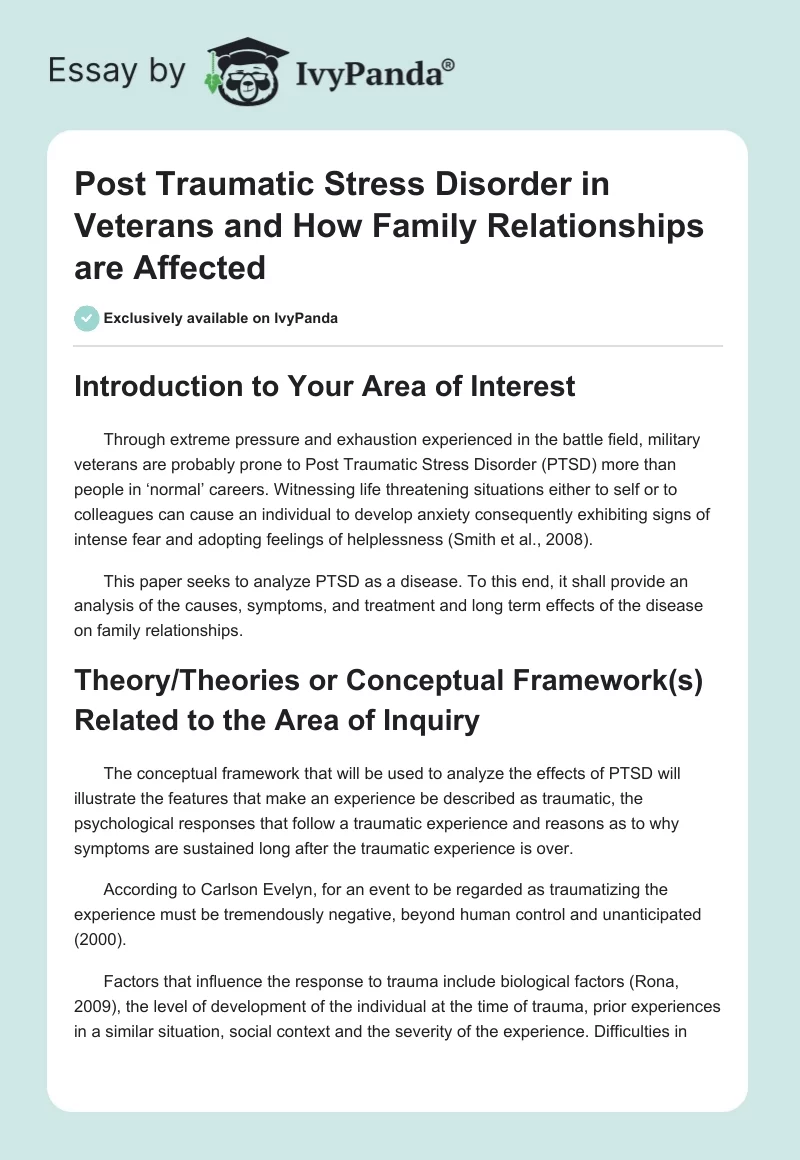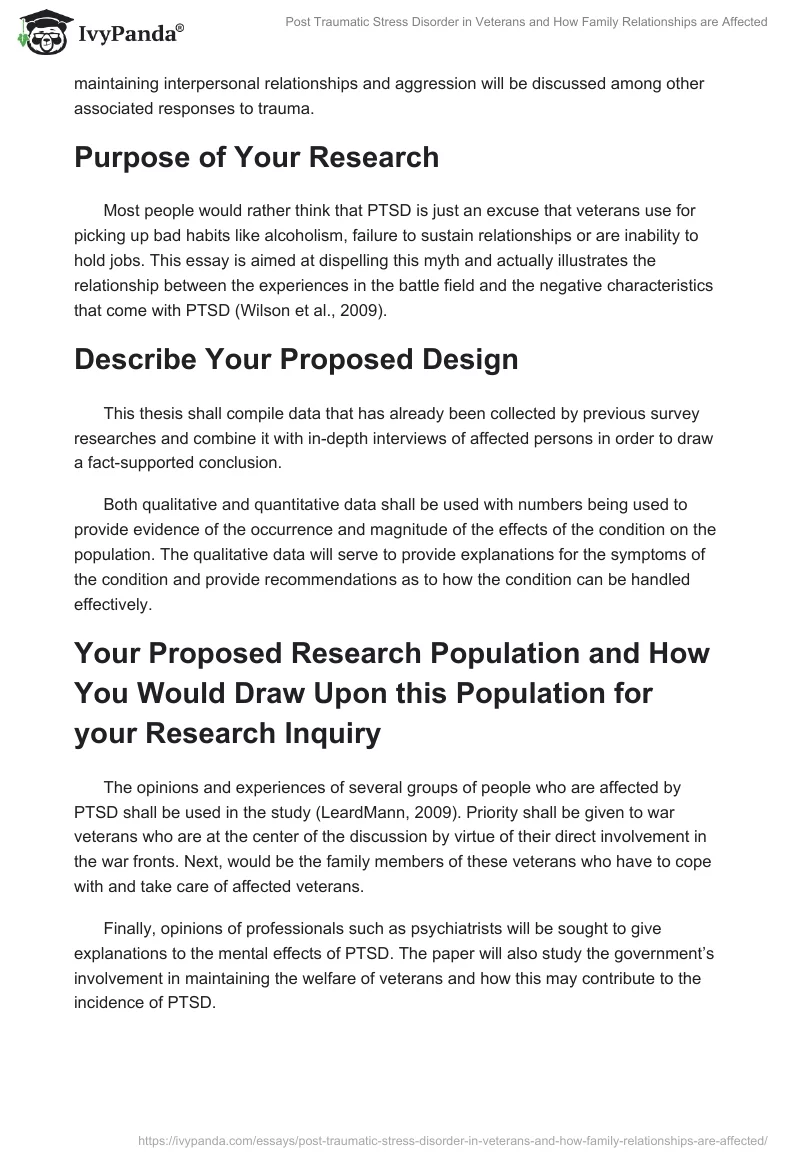Introduction to Your Area of Interest
Through extreme pressure and exhaustion experienced in the battle field, military veterans are probably prone to Post Traumatic Stress Disorder (PTSD) more than people in ‘normal’ careers. Witnessing life threatening situations either to self or to colleagues can cause an individual to develop anxiety consequently exhibiting signs of intense fear and adopting feelings of helplessness (Smith et al., 2008).
This paper seeks to analyze PTSD as a disease. To this end, it shall provide an analysis of the causes, symptoms, and treatment and long term effects of the disease on family relationships.
Theory/Theories or Conceptual Framework(s) Related to the Area of Inquiry
The conceptual framework that will be used to analyze the effects of PTSD will illustrate the features that make an experience be described as traumatic, the psychological responses that follow a traumatic experience and reasons as to why symptoms are sustained long after the traumatic experience is over.
According to Carlson Evelyn, for an event to be regarded as traumatizing the experience must be tremendously negative, beyond human control and unanticipated (2000).
Factors that influence the response to trauma include biological factors (Rona, 2009), the level of development of the individual at the time of trauma, prior experiences in a similar situation, social context and the severity of the experience. Difficulties in maintaining interpersonal relationships and aggression will be discussed among other associated responses to trauma.
Purpose of Your Research
Most people would rather think that PTSD is just an excuse that veterans use for picking up bad habits like alcoholism, failure to sustain relationships or are inability to hold jobs. This essay is aimed at dispelling this myth and actually illustrates the relationship between the experiences in the battle field and the negative characteristics that come with PTSD (Wilson et al., 2009).
Describe Your Proposed Design
This thesis shall compile data that has already been collected by previous survey researches and combine it with in-depth interviews of affected persons in order to draw a fact-supported conclusion.
Both qualitative and quantitative data shall be used with numbers being used to provide evidence of the occurrence and magnitude of the effects of the condition on the population. The qualitative data will serve to provide explanations for the symptoms of the condition and provide recommendations as to how the condition can be handled effectively.
Your Proposed Research Population and How You Would Draw Upon this Population for your Research Inquiry
The opinions and experiences of several groups of people who are affected by PTSD shall be used in the study (LeardMann, 2009). Priority shall be given to war veterans who are at the center of the discussion by virtue of their direct involvement in the war fronts. Next, would be the family members of these veterans who have to cope with and take care of affected veterans.
Finally, opinions of professionals such as psychiatrists will be sought to give explanations to the mental effects of PTSD. The paper will also study the government’s involvement in maintaining the welfare of veterans and how this may contribute to the incidence of PTSD.
Examples of Research Data That May Be Collected
Quantitative data to be used in this thesis include the percentage of veterans suffering PTSD amongst those who return from war and the percentage of those who are eventually treated from this group. Qualitative data includes an analysis of the success of support groups and the importance of professional psychiatric help in addressing the condition.
Social Change Implications
This thesis will contribute to Walden University’s mission of instigating positive social change by helping individuals clearly understand the experience and situations that veterans face in the war fronts and how these experiences weave into the undesirable condition that is PTSD.
This essay will not only study evidence that has been previously recorded on the effects of the disease, but will also provide recommendations as to what measures can be taken in order to reduce the incidence of the condition. In conclusion, this thesis will provide recommendations as to what actions institutions like colleges can take in order to provide social support to veterans; a factor that will help make them (veterans) feel the appreciation of their contribution.
Other Information about Your Dissertation Proposal
Veterans on coming back from the battle fields find it extremely difficult to function normally in the societies they were brought up in. Their relationships with family members and members of the wider community are immensely affected and more often than not these relationships are destroyed irreparably.
Most of the blame generally tends to fall on the affected veterans for consciously signing up to the force and the effects of PTSD are either perceived as self inflicted or imaginary. This thesis shall review papers that have been written on PTSD by professionals such as Evelyn B. Carlson and provide the necessary link between the condition and the war front while emphasizing the effect on relationships.
References
Carlson E.B. (2000). A conceptual framework for the impact of traumatic experiences.
Sage journal online, 1(1), 4-28. DOI: 10.1177/1524838000001001002.
Hoge C.W. et al. (2008). Mild traumatic brain injury in U.S. soldiers returning from Iraq. N Engl J Med, 358,453.
LeardMann, C. A., Smith, T. C., Smith, B., Wells, T. S., Ryan, M. K., for the Millennium
Cohort Study Team, (2009). Baseline self reported functional health and vulnerability to post-traumatic stress disorder after combat deployment: prospective US military cohort study. BMJ 338: b1273-b1273.
Rona R. J. (2009). Is Previous Psychological Health Associated With the Likelihood of
Iraq War Deployment? An Investigation of the “Healthy Warrior Effect”. Am J Epidemiol, 169, 1362-1369.
Smith TC. et al. (2008). New onset and persistent symptoms of post-traumatic stress disorder self reported after deployment and combat exposures: Prospective population based US military cohort study. BMJ 2008. DOI: 10.1136/bmj.39430.638241.AE.
Wilson, J., Jones, M., Fear, N. T., Hull, L., Hotopf, M., Wessely, S., Rona, R. J. (2009).
Is Previous Psychological Health Associated With the Likelihood of Iraq War Deployment? An Investigation of the “Healthy Warrior Effect”. Am J Epidemio,l 169, 1362-1369


